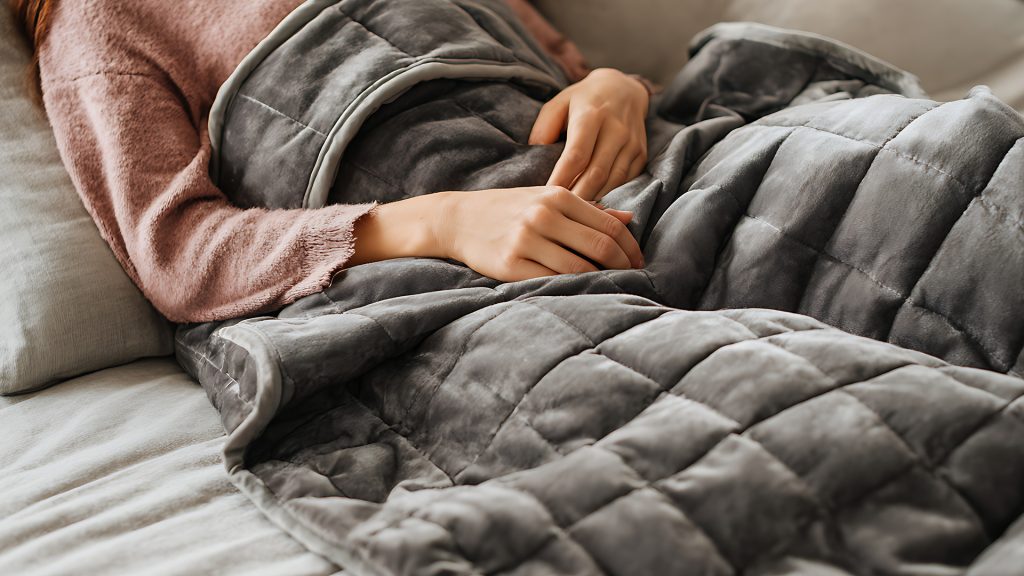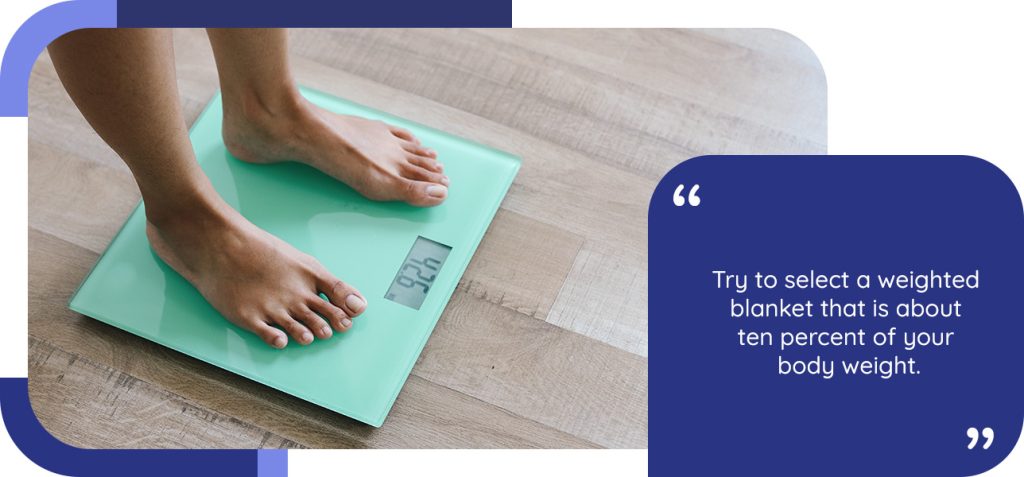Why use a weighted blanket?

Have you ever noticed how a warm, firm hug can instantly make you feel calmer? Or how swaddling helps babies sleep more peacefully? Weighted blankets work on the same principle, using gentle, distributed pressure to help adults find that same sense of calm and security that promotes better sleep.
Weighted blankets have gained tremendous popularity in recent years, moving from therapeutic settings into bedrooms across Britain. But what exactly makes them different from ordinary bedding, and could one genuinely improve your sleep quality?
This comprehensive guide explores everything you need to know about weighted blankets. You’ll discover the science behind their calming effects, learn who benefits most from using them, and understand how to choose and use one safely. Whether you’re struggling with sleep, managing anxiety, or simply curious about this sleep trend, you’ll find clear, practical information to help you decide if a weighted blanket belongs in your bedroom.
Table of contents
1. Understanding weighted blankets
2. The science of deep pressure stimulation
3. Who benefits from weighted blankets?
4. Selecting your ideal weighted blanket
5. Using your weighted blanket safely
6. Maximising your sleep environment
7. Caring for your weighted blanket
8. Experience complete comfort with Adjustamatic
1. Understanding weighted blankets
A weighted blanket looks much like any other blanket, but with one crucial difference: it’s significantly heavier. While a typical blanket might weigh a kilogram or two, weighted blankets range from five to fifteen kilograms. This extra weight comes from materials sewn into pockets throughout the blanket, creating even pressure across your entire body when you lie beneath it.
How weighted blankets are made
Most weighted blankets use one of two construction methods. The most common design resembles a duvet, with an outer fabric shell containing numerous small pockets. Each pocket holds weighted materials – typically tiny glass beads, plastic pellets, or sometimes natural materials like rice or millet. These pockets ensure the weight stays evenly distributed rather than shifting to one side.
The second type uses dense, chunky knit construction. These blankets achieve their weight through thick yarn rather than added fillings. While they look stylish and don’t require internal pockets, they can be less flexible in terms of weight options and may not breathe as well as filled versions.
Quality matters in construction. Well-made weighted blankets feature strong stitching to prevent beads from migrating between pockets, durable fabric that withstands the extra weight, and materials that won’t bunch or create uncomfortable lumps. Many come with removable, washable covers for easier maintenance.
The feeling they create
Lying under a weighted blanket feels quite different from regular bedding. Rather than simply providing warmth, the blanket applies gentle, consistent pressure across your body. Many people describe it as feeling like a sustained, comforting hug or being gently held.
This sensation takes some adjustment. Your first night might feel unusual as your body adapts to the extra weight. Most people find they quickly grow accustomed to the feeling, often to the point where regular blankets feel insufficiently comforting afterward.

2. The science of deep pressure stimulation
The effectiveness of weighted blankets relies on something called deep pressure stimulation. This therapeutic technique has been used for years in occupational therapy and works by activating specific responses in your nervous system.
Your body’s calming response
When you experience firm, distributed pressure, your nervous system interprets this as a safety signal. This triggers a shift from your sympathetic nervous system (responsible for alertness and stress responses) to your parasympathetic nervous system (which promotes rest and relaxation).
This shift produces measurable changes in your body. Your heart rate typically slows. Your breathing becomes deeper and more regular. Muscle tension decreases. These physical changes signal to your brain that it’s safe to relax and sleep.
Research has documented these effects. Studies show that people using weighted blankets often experience lower cortisol levels – cortisol being the primary stress hormone that can interfere with sleep. The pressure also stimulates production of serotonin, a neurotransmitter that promotes calm and wellbeing, which your body then converts to melatonin: the sleep hormone that regulates your sleep-wake cycle.
The melatonin connection
Researchers have found that people sleeping under weighted blankets show approximately thirty percent higher melatonin levels compared to those using regular blankets. This increase in natural melatonin could explain why many users report falling asleep faster and experiencing deeper sleep.
This hormonal response happens naturally, without medication or supplements. The gentle pressure simply encourages your body to produce more of its own sleep-promoting chemicals, working with your natural rhythms rather than overriding them.
3. Who benefits from weighted blankets?
While anyone might enjoy the comfort of a weighted blanket, certain groups can experience particularly significant benefits.
Managing anxiety and stress
People dealing with anxiety often find weighted blankets especially helpful. The constant pressure provides a physical anchor during anxious moments, offering something tangible to focus on when thoughts begin racing. This grounding effect can interrupt the anxiety cycle, making it easier to calm both mind and body.
The blanket’s effects on stress hormones make it particularly useful for evening anxiety that interferes with sleep. Many users report that wrapping themselves in their weighted blanket becomes part of their wind-down routine, signalling to their body that the day’s stresses are over.
For those experiencing general life stress rather than clinical anxiety, weighted blankets offer a drug-free way to promote relaxation. The physical comfort can be particularly welcome during difficult life periods when emotional support feels needed.
Improving sleep quality
Sleep difficulties affect millions of people, and weighted blankets address several common sleep challenges. For those who toss and turn throughout the night, the blanket’s weight naturally reduces movement, leading to more stable sleep positions and fewer disruptions.
People who struggle to fall asleep often find the pressure helps quiet “mental chatter”. Rather than lying awake with racing thoughts, the physical sensation provides a focus point that can ease the transition into sleep. Increased melatonin production supports this natural sleep onset.
Light sleepers who wake frequently during the night may find the consistent pressure helps them sleep more soundly. The blanket creates a cocoon-like environment that maintains steady sensory input throughout the night, reducing the likelihood of small disturbances causing full awakening.
Supporting neurodivergent individuals
The neurodivergent community, particularly people with autism spectrum conditions or ADHD, has long recognised the benefits of weighted blankets. For individuals who experience sensory processing differences, the predictable, even pressure can be profoundly calming.
People with autism often find that weighted blankets help manage sensory overload. The deep pressure provides strong, consistent sensory input that can override confusing or overwhelming environmental stimuli. This makes it easier to relax and prepare for sleep.
Those with ADHD frequently report that weighted blankets help with the restlessness that can make falling asleep challenging. The physical weight provides just enough sensory input to help a busy mind settle without being distracting or uncomfortable.
Parents of neurodivergent children should note that while weighted blankets can be helpful, they require careful selection and monitoring. Professional guidance ensures safe and effective use for younger individuals with special needs.
Easing chronic pain
While not a cure for chronic pain conditions, weighted blankets can provide complementary comfort for people managing ongoing discomfort. The steady pressure may help decrease pain perception by providing competing sensory input that can partially override pain signals.
People with fibromyalgia, a condition characterised by widespread pain and tenderness, often find the gentle pressure soothing rather than aggravating. The blanket’s weight distributes evenly, avoiding pressure points that might trigger pain flares.
Arthritis sufferers sometimes report that the warmth and pressure combination helps ease joint stiffness, particularly in the morning. While the blanket won’t reduce inflammation, the comfort it provides can make pain more manageable during rest periods.
4. Selecting your ideal weighted blanket
Choosing the right weighted blanket requires careful consideration of several factors. The wrong choice can be uncomfortable or even unsafe, while the right selection can transform your sleep experience.
Finding your perfect weight
The golden rule for weighted blankets is selecting one that weighs approximately ten percent of your body weight. This guideline provides enough pressure to be therapeutic without being overwhelming. Some people prefer slightly more or less weight, but staying within the eight to twelve percent range ensures both comfort and safety.
|
Your Weight |
Blanket Weight |
|
45-54 kg |
5-6 kg |
|
55-63 kg |
6-7 kg |
|
64-72 kg |
7-8 kg |
|
73-81 kg |
8-9 kg |
|
82-90 kg |
9-10 kg |
|
91-100 kg |
10-11 kg |
If you fall between standard weights, it’s generally better to choose the lighter option, especially for your first weighted blanket. You can always add a regular blanket on top if you want more pressure, but you can’t make an overly heavy blanket lighter.
Couples face a unique challenge since body weights often differ significantly. Rather than compromising with an average weight that suits neither person, many couples find individual weighted blankets work better, used over a shared flat sheet.
Size considerations
Unlike regular bedding that often hangs over bed edges, weighted blankets should roughly match your body size rather than your bed size. An oversized weighted blanket can pull downward uncomfortably or slide off during the night.
For individual use, a blanket that covers you from shoulders to feet without excessive overhang works best. This typically means choosing a size smaller than your mattress – a single weighted blanket for a double bed user, for instance.
Consider how you sleep when selecting size. If you curl up, a smaller blanket might suffice. If you stretch out or change positions frequently, ensure the blanket is long and wide enough to maintain coverage throughout the night.
Materials and comfort features
The filling material affects both comfort and maintenance. Glass beads are the premium option – they’re dense (allowing thinner blankets), silent when you move, and generally machine-washable. Plastic pellets cost less but can be noisier and may retain more heat. Natural fillings like rice or millet are eco-friendly but typically can’t be washed and may attract pests.
Fabric choice significantly impacts comfort, especially for those who sleep warm. Cotton covers breathe well and suit most climates. Bamboo-derived fabrics offer excellent moisture-wicking for hot sleepers. Minky or fleece covers provide extra warmth but may be too hot for year-round use.
Many weighted blankets now come with removable covers, similar to duvet covers. This feature simplifies washing and allows you to change covers seasonally or for variety. Look for covers with ties or snaps inside to keep the weighted insert from bunching.

5. Using your weighted blanket safely
While weighted blankets are safe for most adults, proper use ensures you get benefits without risks. Understanding safety guidelines protects both you and any vulnerable individuals in your household.
Essential safety rules
The most critical safety rule concerns capability: you must be able to move and remove the blanket independently. If you cannot easily push the blanket off yourself, it’s too heavy. This ability ensures you can adjust or remove the blanket if you become too warm, need to get up, or feel uncomfortable.
Never use adult weighted blankets with babies, toddlers, or young children. Children under eight years old shouldn’t use weighted blankets unless specifically designed for their age and weight, and even then, only with professional guidance and supervision. The risk of suffocation or entrapment is too significant for unsupervised use.
Position the blanket properly for safe use. Lay it over your regular sheet rather than tucking it tightly under the mattress. This allows easy removal and prevents feeling trapped. The blanket should cover your body but not your face or head.
Medical considerations
Certain health conditions require caution or make weighted blankets inappropriate. Respiratory conditions like sleep apnoea, severe asthma, or COPD can be worsened by chest pressure. The extra weight might make breathing more difficult, especially during sleep when respiratory drive naturally decreases.
Circulation problems, including diabetes-related neuropathy or peripheral artery disease, mean you might not feel if the blanket is cutting off blood flow. Heart conditions may also be affected by the pressure on the chest. Osteoporosis or recent fractures make extra weight potentially harmful to fragile bones.
Claustrophobia or panic disorders triggered by feeling restricted obviously make weighted blankets unsuitable. The sensation that some find comforting can trigger anxiety in those who feel confined by pressure.
Always consult your doctor before using a weighted blanket if you have any chronic health condition. They can assess whether the benefits outweigh any risks in your specific situation.
Getting started gradually
Your body needs time to adjust to sleeping under extra weight. Start by using the blanket for short periods while awake – perhaps while reading or watching television. This lets you experience the sensation while fully alert and able to remove it easily.
Progress to short naps before attempting full night use. Some people adapt immediately, while others need several nights to feel completely comfortable. There’s no rush; take whatever time you need to feel secure.
Monitor your comfort throughout adjustment. Feeling too warm is common initially as your body adapts. You might need to adjust your room temperature or sleepwear. Some people find they need lighter pyjamas or fewer layers under the weighted blanket.
6. Maximising your sleep environment
A weighted blanket works best as part of a comprehensive approach to better sleep. Combining it with other sleep improvements multiplies the benefits and addresses multiple factors affecting rest quality.
Creating optimal comfort
Your mattress and pillow remain fundamental to good sleep, even with a weighted blanket. A supportive mattress that maintains proper spinal alignment prevents the aches that can disrupt sleep. Poor support undermines any benefits from the weighted blanket.
Room temperature becomes even more important when using a weighted blanket. The extra layer can trap heat, so you might need to lower your thermostat slightly. Most people sleep best in rooms between 16-19°C, but weighted blanket users often prefer the cooler end of this range.
Darkness signals your body to produce melatonin, working together with the weighted blanket’s effects. Blackout curtains or eye masks enhance this natural process. Similarly, limiting screen time before bed prevents blue light from interfering with melatonin production.
Establishing helpful routines
Consistency strengthens your body’s sleep-wake cycle. Using your weighted blanket at the same time each night reinforces the signal that sleep time has arrived. This routine becomes a powerful sleep cue over time.
Create a calming pre-sleep ritual that includes your weighted blanket. Perhaps you wrap yourself in it while reading, listening to quiet music, or practicing gentle stretches. This transition period helps your mind shift from daily activities to rest.
Avoid using the weighted blanket for activities that might create unhelpful associations. If you work from bed or watch television under your weighted blanket, your brain might not associate it primarily with sleep.
7. Caring for your weighted blanket
Proper maintenance extends your blanket’s life and keeps it hygienic. The weight that makes these blankets special also makes care more challenging than regular bedding.
Washing and drying
Always check manufacturer instructions before washing. Some weighted blankets are fully machine-washable, others only spot-cleanable, and some have removable covers that wash separately. Ignoring care instructions can damage the blanket or your washing machine.
For machine-washable blankets, use cold or warm water on a gentle cycle. Hot water can damage some filling materials or cause fabric shrinkage. Use mild detergent and skip fabric softener, which can affect the blanket’s breathability.
Drying requires patience. Many weighted blankets are too heavy for tumble dryers when wet. Air drying is often recommended, though this can take considerable time. Lay the blanket flat if possible, rotating periodically for even drying. Some people drape them over multiple drying racks or sturdy outdoor furniture.
Long-term maintenance
Inspect your blanket regularly for wear. Check seams, especially around the edges where stress is highest. Small repairs prevent larger problems – a few loose stitches fixed quickly can prevent beads from escaping later.
Protect your investment with proper storage when not in use. Fold carefully to avoid stressing seams, and store in a cool, dry place. Avoid hanging weighted blankets long-term, as the weight can stretch the fabric.
Consider having a lighter-weight blanket for summer months. Some people use their weighted blanket year-round by adjusting other bedding, while others prefer seasonal rotation. Having options prevents overheating during warm weather.

8. Experience complete comfort with Adjustamatic
Your search for better sleep has led you to explore weighted blankets, and understanding their benefits is just the beginning. While these therapeutic blankets can significantly improve rest through gentle pressure, they work even better when combined with a complete sleep system designed for optimal comfort and support.
Creating your perfect sleep sanctuary
At Adjustamatic, we’ve spent over sixty years understanding what truly makes the difference between restless nights and restorative sleep. While we specialise in adjustable beds and furniture rather than weighted blankets themselves, we know that great sleep comes from multiple comfort elements working together harmoniously.
Imagine combining the calming pressure of your weighted blanket with an adjustable bed that lets you find your perfect sleeping position. Elevate your legs slightly to improve circulation while your weighted blanket provides soothing pressure. Raise your upper body to ease breathing or reduce acid reflux, all while remaining comfortably cocooned. This combination addresses multiple sleep challenges simultaneously.
The foundation of better rest
Adjustable positioning for enhanced comfort
Our adjustable beds complement weighted blankets beautifully. When you can fine-tune your sleeping position, the distributed pressure of a weighted blanket becomes even more effective. No more propping pillows that slip away or struggling to find a comfortable angle – our beds provide stable, adjustable support that works perfectly with weighted bedding.
Premium mattresses that complete the system
Our AirFlow® Orthopaedic Mattresses are designed to work with adjustable bases while providing the support your body needs. The cooling properties help counteract any extra warmth from a weighted blanket, while the orthopaedic design ensures proper spinal alignment regardless of your chosen position.
Thoughtful features for real needs
Every Adjustamatic bed includes features that enhance the weighted blanket experience. Quiet motors won’t disturb the calm a weighted blanket creates. Memory positions let you return instantly to your optimal sleeping angle. Under-bed lighting helps you navigate safely without fully waking if you need to adjust or remove your blanket during the night.
Supporting your journey to better sleep
We understand that investing in better sleep can feel overwhelming when you’re already dealing with sleep challenges. Our team specialises in making this process simple and reassuring. We’ll help you understand how an adjustable bed could work with your weighted blanket and other sleep aids to create your ideal rest environment.
Our free home consultations let you experience adjustable comfort in your own bedroom. Feel how different positions affect your comfort while using your weighted blanket. Discover which features would genuinely benefit your specific situation. There’s never any pressure – just honest advice about creating your optimal sleep setup.
Your next step toward transformative rest
You’ve learned how weighted blankets can improve sleep through deep pressure stimulation. Now discover how pairing one with an Adjustamatic adjustable bed could multiply those benefits. Our complete sleep systems address the elements of comfort that weighted blankets alone cannot provide.
Call us free on 0800 689 9823 to discuss how our adjustable beds and mattresses could enhance your weighted blanket experience. Our sleep specialists understand the importance of comprehensive comfort solutions and can explain how our products work together with weighted blankets for optimal results.
Request our free information pack to explore how adjustable beds provide the perfect foundation for all your comfort needs, including weighted blanket use. See how others have transformed their sleep by combining multiple comfort strategies.


